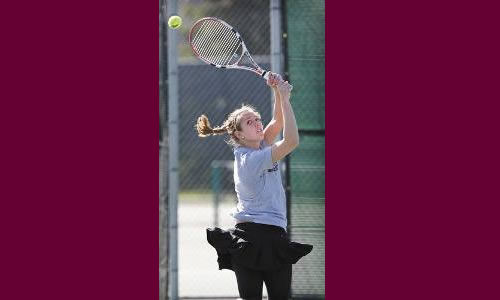
Overcoming Adversity
Two years ago, Andrea Rognlien had a blood clot in her shoulder that led to having a rib removed. And that led to a collapsed lung.
In hindsight, those events may have been the best things to happen to her tennis career.
"I feel like I'm better than I was," said the Concordia senior. "I don't think I'd be playing at this level if that hadn't have happened."
Since Rognlien found out she had a blood clot in her right shoulder in early 2010, she has maneuvered through the physical and emotional ups and downs.
She's emerged a stronger person and better tennis player. Rognlien has a singles record of 14-2 in her final collegiate season, which will likely end at the end of April.
Her 14 wins are the most in a season for a Concordia women's tennis player since 1990.
"She is the best player in my seven years here," said Cobbers head coach Troy Hanestad, who added she is arguably one of the best in program history.
Feb. 13, 2010 was the first time Rognlien started to notice something wasn't right. She woke up that morning and noticed a "little" black and blue mark on the inside of her right bicep. The condition worsened later that day as she prepared for a match, which was the first of her sophomore season.
Her right arm swelled up from her shoulder to her fingertips, she said. It was about twice the size as her left arm. Rognlien took a trip to the hospital that day, but the cause could not be pinpointed. The swelling went down by the end of the day. Rognlien was back on the tennis court the next day, and the arm swelled up again.
"It felt like my arm was going to explode. It hurt so bad," said Rognlien, who played high school tennis at Fargo Shanley.
A trip to the emergency room uncovered a blood clot in a vein in her right shoulder. She was diagnosed with Thoracic Outlet Syndrome.
Her clavicle and first rib were pinching a vein when she lifted her right arm to serve a ball or hit and overhead shot.
Rognlien ended up at the Mayo Clinic in Rochester, Minn., for treatment. On May 5, 2010, Rognlien had surgery at Mayo to remove her first rib to remedy the condition.
A few days later, Rognlien returned home. The next morning, she woke up and had difficulty breathing. She ended up being airlifted back to Rochester. Blood pooling around her lung caused it to collapse.
"I didn't think I was going to live past that," she said. "I know it sounds a little bit dramatic."
Mike Rognlien, Andrea's dad, joined his daughter on the flight to Rochester.
Mike, who has more than 30 years of experience in the medical field, said it was tough to stomach.
"When it's your own kid, it turns it," Mike said. "It's tough to see your kid as white as a sheet."
Andrea Rognlien was at Mayo for more than a week before she fought through that setback. A "very slow" rehabilitation ensued, said Rognlien who missed her sophomore season. She returned to competition one year to the day (Feb. 13, 2011) after she first noticed the symptoms of the clot.
"That first match, it was very emotional," Rognlien said. "I didn't know if I could compete again. I didn't know if that would be the same for me."
About halfway through her junior year, Rognlien said, she pondered giving up the sport she loved. She wasn't sure if she could get back to the level she was at before the blood clot.
"I didn't want this whole thing to ruin tennis for me completely," she said. "I had thought about quitting and wanted to be done."
Again, she chose to fight.
By the end of her junior season, she hit a mental turning point. She decided to not set too many goals and be burdened by wins and losses. She let go of all expectations. She feels that is one of the reasons her game has blossomed this spring.
"I think when you focus on just winning matches you limit yourself," she said. "You hold yourself back. … I feel strong just as a person. Aside from tennis, this whole thing taught me what I can handle as a person."
Mike also noticed his daughter's personal growth through adversity.
"She doesn't need tennis to be Andrea," he said.